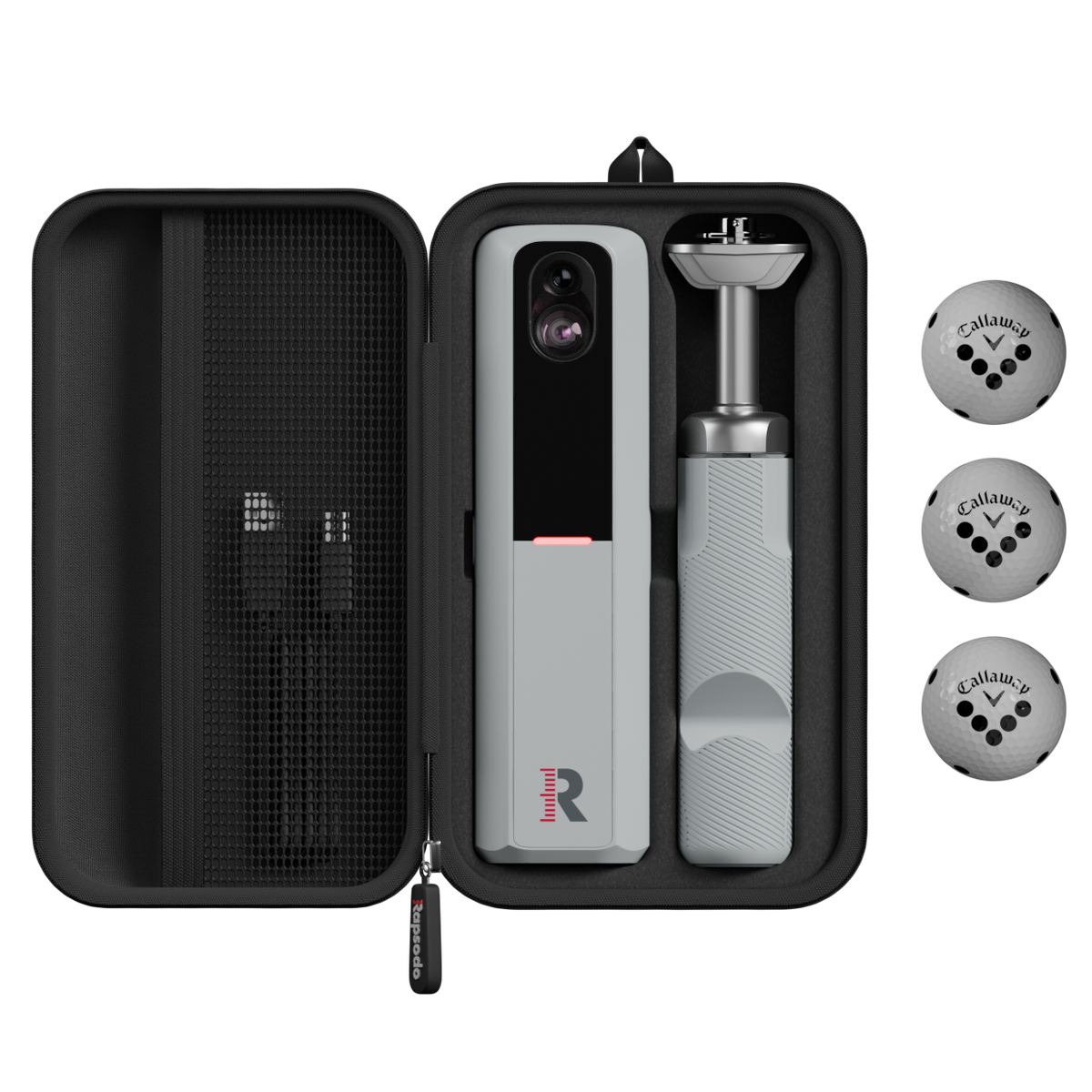Have you ever wondered why some premium golf balls seem to soar effortlessly through the air, while others give you a satisfying “thwack” off the clubface? The answer lies in a crucial concept known as golf ball compression. Understanding the science behind golf ball compression can significantly improve your game.
In this comprehensive guide, we will show you a golf ball compression chart of multiple compressions.
Overview in 10 Seconds
This comprehensive guide explores golf ball compression and its impact on performance in tabular form.. It emphasizes the importance of selecting the right compression based on your swing speed. The article highlights the need to align compression with feel and control for optimal results. It also provides methods to measure swing speed and recommends compression ratings for different player types.
| Titleist | Bridgestone | Taylor Made | Callaway | Srixon | Spalding | Penfold | Precept |
|---|---|---|---|---|---|---|---|
| 52.0% | 12.0% | 8.0% | 8.0% | 8.0% | 4.0% | 4.0% | 4.0% |
Golf Ball Compression Guide
Golf ball compression is something that only PGA tour professionals or serious golfers consider. Mainly because they know the importance of it. Golf is a game that is purely based on science. It is a unique combination of feel and physics. Both of these factors have to correlate for an improved and maximized golf performance. If you consider only one, the other will haunt you as well as ruin your game.
Have you ever wondered why there are 500+ best quality golf balls for golfers? The answer is simple but it contains a whole world of information. Each golf ball is made for a specific golfer type. All golfers are not the same. If your flightmate is hitting long shots off the tee with his Titleist Pro V1, it does not mean that you will replicate the shots with a similar swing style or swing curvature.

Imagine that you are outplaying the Titleist Pro V1 with your Callaway Warbird golf ball. So where does the difference lie? Is Warbird better than the Pro V1? Or the golfing gods are on your side? We can speculate as much as we want but the real difference lies in the golf ball compression. You, being a critique of your game have a clear grasp of your golf skills. You know that your swing speed is ideal for the Callaway ball compression. Whereas your playing partners think that the higher the price and the better the reputation will produce magical shots. WRONG
To simply put, golf ball compression refers to the degree to which a golf ball deforms upon impact with the clubface. This fundamental characteristic plays a pivotal role in determining how the ball behaves during flight, affecting factors like distance, spin, feel, and control. By exploring the intricate relationship between golf ball compression and performance, you can make informed decisions that elevate your play to new heights.
Golf Ball Compression Chart
| Brand | Model | Compression Rating | Cover Material | Swing Speed | Layers | Price $/Dozen |
|---|---|---|---|---|---|---|
| Vice | Drive | 32 | Surlyn | Slow | 2 | 19.99 |
| TaylorMade | Soft Response | 35 | Ionomer | Slow | 3 | 29.99 |
| Wilson Staff | Duo Soft | 35 | Ionomer | Slow | 2 | 22.99 |
| Vice | Pro Soft | 35 | Urethane | Slow | 3 | 34.51 |
| Titleist | TruFeel | 40 | Urethane | Slow | 2 | 24.99 |
| Callaway | Supersoft | 40 | Ionomer | Slow | 2 | 24.99 |
| TaylorMade | Noodle Long & Soft | 45 | Ionomer | Slow | 2 | 24.99 |
| Bridgestone | e6 | 50 | Surlyn | Slow | 2 | 24.99 |
| Srixon | Soft Feel | 60 | Ionomer | Slow | 2 | 22.99 |
| Callaway | ERC Soft | 60 | Ionomer | Slow | 2 | 34.99 |
| Bridgestone | Tour B RX | 66 | Urethane | Moderate | 3 | 44.99 |
| Titleist | Velocity | 70 | Ionomer | Moderate | 2 | 29.99 |
| Callaway | Chrome Soft | 72 | Urethane | Moderate | 3 | 49.99 |
| TaylorMade | Tour Response | 73 | Urethane | Moderate | 3 | 42.99 |
| Srixon | Q-Star | 77 | Urethane | Moderate | 2 | 27.99 |
| Titleist | AVX | 80 | Urethane | Moderate | 3 | 54.99 |
| TaylorMade | TP5 | 87 | Urethane | Moderate High | 5 | 49.99 |
| Titleist | Pro V1 | 90 | Urethane | Moderate High | 3 | 54.99 |
| Callaway | Warbird | 90 | Ionomer | High | 2 | 19.99 |
| Srixon | Z-Star | 90 | Urethane | High | 3 | 47.99 |
| Vice | Pro Plus | 90 | Urethane | High | 4 | 36.99 |
| Mizuno | RB Tour | 95 | Urethane | High | 4 | 42.99 |
| TaylorMade | TP5X | 98 | Urethane | High | 5 | 49.99 |
| Titleist | Pro V1X | 100 | Urethane | High | 4 | 54.99 |
| Bridgestone | Tour B X | 100 | Urethane | High | 3 | 44.99 |
| Maxfli | Tour X | 101 | Urethane | High | 4 | 46.99 |
| Wilson Staff | Model R | 101 | Urethane | High | 4 | 49.99 |
| Srixon | Z-Star XV | 102 | Urethane | High | 4 | 47.99 |
| Titleist | Pro V1X Left Dash | 102 | Urethane | High | 4 | 54.99 |
| Mizuno | RB Tour X | 110 | Urethane | High | 4 | 42.99 |
Golf Ball Compression: What It Means and How It Works
Golf ball compression is measured in a unit called “compression rating.” This rating indicates the force needed to compress the ball by a certain percentage of its original diameter. Lower compression balls require less force to deform, making them suitable for players with slower swing speeds. Conversely, higher compression balls demand more force and are preferred by players with faster swings.
When you strike a high quality golf ball, it momentarily flattens against the clubface. The ball then quickly rebounds, regaining its original shape as it leaves the club.
This deformation and subsequent restoration of form happen within milliseconds, creating a transfer of energy that propels the ball forward. The compression rating directly influences how efficiently this energy is transferred, impacting the ball’s launch angle, spin rate, and overall performance.
Dynamics of Distance and Compression
Golf balls are equally important as your golf clubs are. With the right golf balls online for your skills and the wrong equipment, or vice versa, you will constantly question your playing skills. You will think that something is wrong. Your swing, your stance, your mindset, or whatnot. But golf is not that much complicated. It could simply be an unsuitable golf ball that is hindering your game performance.
Before we move on to the golf ball compression chart, let’s talk about the key factors that could be that should be aligned for finding the best golf ball compression for your game. Each swing speed and feel calls for a different golf ball compression.
Maximizing Distance
Achieving optimal distance with your shots involves finding the delicate balance between compression and swing speed. Golfers with slower swings benefit from lower compression balls, as these balls compress more efficiently, resulting in higher launch angles and greater distance. On the other hand, high swing speeds work better with higher compression balls, which offer lower launch angles for a penetrating trajectory and maximum roll.
Balancing Compression with Feel and Control
Golfers often seek that elusive “feel” – the tactile feedback that provides a sense of connection with the ball. Golf ball compression influences feel by affecting the level of deformation and the time it takes for the ball to regain its shape. Lower compression balls offer a softer feel upon impact, making them suitable for players who prioritize control and precision. Higher compression balls, while providing a firmer feel, may sacrifice a bit of control for added distance.
You often see PGA pros hit the ball all around off the tee and like many golfers, you’d also think that you could play that shot better than them. Well, a part of it is true if only you know the golf ball compression that works best for you. However, PGA Pros use high compression golf balls which will be mentioned in the golf ball compression chart below. They are ultimately going for the long shots because, during Tour and Tournaments, a few yards could make all the difference.
So at times, when they miss the fairways, don’t undermine their playing skills. You can try the same for yourself if you have a Rory McIlroy swing speed. But how does one measure the swing speed? Let’s find out.
Golf Ball Compression of Top Golfers
The following chart is based on the Major wins.
| Rank | Player | Country | Weeks on Top Ranking | Majors | Latest Golf Ball | Compression Rating |
|---|---|---|---|---|---|---|
| 1 | Tiger Woods | United States | 683 | 15 | Bridgestone Tour B X | 100.0 |
| 5 | Nick Faldo | England | 97 | 6 | Titleist Balata | 90.0 |
| 12 | Brooks Koepka | United States | 47 | 5 | Srixon Z-Star Diamond | 102.0 |
| 6 | Seve Ballesteros | Spain | 61 | 5 | Penfold Tradition | 80.0 |
| 21 | Ernie Els | South Africa | 9 | 4 | Srixon Z-Star XV | 102.0 |
| 4 | Rory Mcllroy | Northern Ireland | 122 | 4 | TaylorMade TP5x | 98.0 |
| 15 | Jordan Spieth | United States | 26 | 3 | Titleist Pro V1x | 100.0 |
| 14 | Vijay Singh | Fiji | 32 | 3 | Titleist Pro V1x | 100.0 |
| 13 | Nick Price | Zimbabwe | 44 | 3 | Precept EV Extra Spin | 80.0 |
| 9 | Jon Rahm | Spain | 52 | 2 | Callaway Chrome Soft X | 95.0 |
| 2 | Greg Norman | Australia | 331 | 2 | Spalding Tour Edition | 90.0 |
| 3 | Dustin Johnson | United States | 135 | 2 | TaylorMade TP5x | 98.0 |
| 22 | Martin Kaymer | Germany | 8 | 2 | Titleist Pro V1 | 90.0 |
| 23 | Justin Thomas | United States | 5 | 2 | Titleist Pro V1x | 100.0 |
| 24 | Bernhard Langer | West Germany | 3 | 2 | Titleist Pro V1 | 90.0 |
| 10 | Jason Day | Australia | 51 | 1 | Bridgestone Tour B X | 100.0 |
| 11 | Ian Woosnam | Wales | 50 | 1 | Titleist Balata | 90.0 |
| 7 | Scottie Scheffler* | United States | 56 | 1 | Titleist Pro V1 | 90.0 |
| 17 | Fred Couples | United States | 16 | 1 | Bridgestone Tour B RXS | 65.0 |
| 18 | David Duval | United States | 15 | 1 | Callaway Chrome Soft | 72.0 |
| 19 | Justin Rose | England | 13 | 1 | Titleist Pro V1x Left Dash | 102.0 |
| 20 | Adam Scott | Australia | 11 | 1 | Titleist Pro V1 | 90.0 |
| 25 | Tom Lehman | United States | 1 | 1 | Titleist Pro V1 | 90.0 |
| 8 | Luke Donald | England | 56 | 0 | Titleist Pro V1x Left Dash | 102.0 |
| 16 | Lee Westwood | England | 22 | 0 | Titleist Pro V1x | 100.0 |
Methods to Measure Your Swing Speed
Following are several methods on how you can measure your swing speed. It is important to mention that you can use your Driver to measure the swing speed. Because a driver club has the highest swing curvature and speed. As you move down the line, the lofts increase, shafts shorten, and swing speed slows down.
Launch Monitor
A launch monitor is a device that uses radar or other technologies to track the golf ball’s flight and your swing speed. It provides detailed data on various aspects of your swing, including clubhead speed, ball speed, and more. Launch monitors are commonly used on driving ranges and by professional golfers.
Golf Swing Speed Radar Device
This handheld device uses Doppler radar or a Mobile Launch Monitor such as Rapsodo MLM 2 Pro to measure the speed of your clubhead during the swing. You simply place the device near the ball or on the ground, and it provides instant feedback on your swing speed. It’s relatively easy to use and convenient for practicing on the driving range.


Golf Simulator
Some golf simulators are equipped with sensors that can measure your swing speed as you hit shots into a screen. These simulators often provide a comprehensive analysis of your swing mechanics, clubhead speed, and ball flight.
High-Speed Video Analysis
While not as direct as other methods, high-speed video analysis can help estimate your swing speed. By recording your swing from multiple angles using a high-speed camera, you can analyze the motion and calculate the time it takes for the clubhead to travel a certain distance, which gives you an approximation of your swing speed.
Smartphone Apps
There are various smartphone best golf apps available that claim to measure golf swing speed. They typically use the phone’s built-in accelerometer to estimate swing speed. While these apps can provide a general idea of your swing speed, they might not be as accurate as dedicated devices.
Swing Speed Training Aids
Some training aids come with built-in sensors that measure your swing speed as you practice. These aids often provide real-time feedback and can help you work on improving your swing mechanics and speed.
However, when using these methods, it is important to ensure accurate and consistent measurements. Warm up properly before measuring, maintain a consistent swing technique, and take multiple measurements to get a reliable average.
Matching Golf Ball Compression Chart to Swing Speed
| Swing Speed Indicator | Speed Range |
|---|---|
| Slow | 50-70 mph |
| Moderate | 70-90 mph |
| High | 90-135 mph |
Understanding your swing speed is essential for selecting the right golf ball compression. Swing speed is typically categorized as slow, moderate, or fast. Here’s how to match your swing speed with the appropriate compression rating:
- Slow Swing Speed (less than 85 mph)
Opt for a ball with a compression rating of 70-80. These balls maximize energy transfer with minimal swing effort.
- Moderate Swing Speed (85-95 mph)
Look for a compression rating in the range of 80-90. This balance ensures a blend of distance and control.
- Fast Swing Speed (more than 95 mph)
Choose a ball with a compression rating of 90 or higher. These balls can handle the high impact of fast swings while providing optimal control.


Selecting the ideal golf ball goes beyond compression alone. Consider other factors such as cover material, dimple pattern, and overall construction for choosing the right golf ball for your game.
| Player Type | Suitable Compression Rating |
|---|---|
| Beginners | 30-60 |
| Intermediate | 60-90 |
| Advanced | 90+ |
People Also Ask
Does golf ball compression impact accuracy?
Yes, golf ball compression influences accuracy. The right compression ensures that the ball responds predictably to your swing, leading to better accuracy.
Can high compression balls cause injuries for slower swingers?
No, using a higher compression ball won’t cause injuries. However, it may result in reduced distance and impact feel for slower swingers.
Are all low compression balls suitable for beginners?
While low compression golf balls are generally forgiving, beginners should still consider their swing speed and playing style when selecting a ball. Many beginner golfers have higher swing speeds than intermediate golf players.
Is ball compression the only factor affecting distance?
No, although golf ball compression is a top-tier factor, distance is influenced by various factors, including swing mechanics, clubhead speed, and launch angle.
Can I switch to a different compression ball mid-game?
During tours and tournaments, it is prohibited. If you are playing a weekend round, you can change and experiment with your golf balls. However, It is recommended to stick with one type of ball throughout a round to maintain consistency in performance.
Are professional golfers more likely to use high compression balls?
Yes, 95% of professional golfers use high compression golf balls mainly because they can control trajectory and spin.
Final Words
Golf ball compression stands as a crucial yet often overlooked aspect of golfing performance. By grasping the dynamics of compression and its effects on distance, feel, and control, you empower yourself to make strategic decisions that enhance your playing experience.
You can always find out the compression rating or visit this blog and go through the golf ball compression chart. Remember, the right and high quality golf balls, matched to your swing speed and preferences can make all the difference in your pursuit of the perfect shot.





